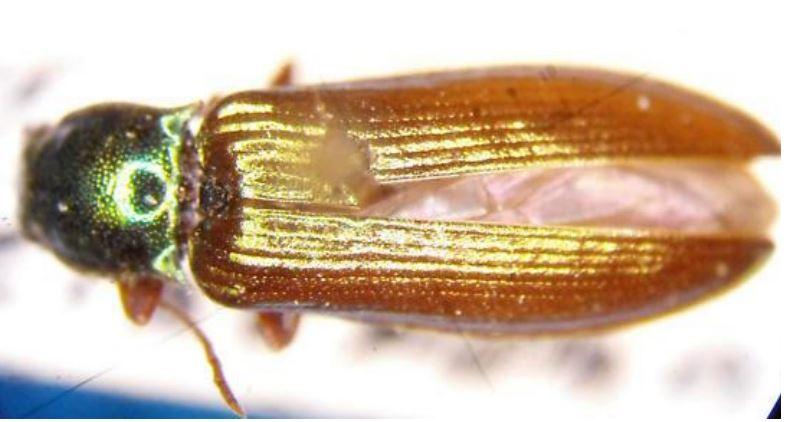Moderate-
High
WDFW designated Hatch’s click beetle as a "Species of Greatest Conservation Need" due to its small number of isolated populations, highly limited distribution and range, and use of specialized, highly restricted, and threatened sphagnum moss bog habitat in the Puget Sound region.
Description and Range
Physical description
Click beetles (Elateridae) have a unique prothorax anatomy that allows them to suddenly flip into the air, emitting a ‘click’ sound. This behavior is used to right the beetle when on its back and to escape predators
Ecology and life history
Hatch's click beetle is a sphagnum bog obligate species, inhabiting bogs between 0 to 1640 feet in elevation.
Sphagnum bogs are unique, peat-forming wetlands with vegetation dominated by sphagnum mosses. Bogs are typically small in size and situated in closed depressions within small watersheds, and thus geographically isolated. An ancient habitat, today bogs persist in relict patches that thousands of years ago were part of more broadly occurring muskeg-like vegetation following the retreat of the glaciers at the end of the last ice age. Sphagnum bogs make up only three percent of the wetlands in western Washington.
Adult Hatch’s click beetles are active in the spring, typically on floating mats of sphagnum moss. The adult beetles have been collected in low, floating sphagnum mats and also encountered in bog shrubs and trees. Larvae have been found near bog margins, above the water line. No formal habitat studies have been conducted for this rare beetle.
Elaterid adults and larvae are known to be carnivorous as well as herbivorous; however, no studies of adult or larval E. hatchi diets have been reported. Adults are thought to feed within flowers on honey dew, pollen, nectar, and the flowers themselves. Larvae appear to inhabit sphagnum moss mats, and likely predate small insects and require multiple years to develop.
Geographic range
Hatch's click beetles are known from only four bogs in lowland King and Snohomish Counties; one of these sites is now highly degraded and unlikely to support this beetle. Extensive searches have been made for Hatch’s click beetle; however, additional surveys in the Puget Trough region are needed. No populations of this species have been estimated.
Climate vulnerability
Sensitivity to climate change
Moderate-
High
Hatch's click beetles (HCB) occupy micro-habitats within the rare and isolated ecological system: North Pacific Bogs and Fens; low elevation (<500m) sphagnum bogs and fens occuring in western Washington. Climate sensitivity for HCB is driven both by likely impacts to their habitat and directly to beetle life stages. Fens and bogs are wetland systems that exist within a narrow range of hydrological input and soil pH; any activity altering hydrological cylces, sedimentation, or nutrient inputs could negatively affect these systems through loss of peat and shifts in vegetation. Significant changes to hydrological cycles, nutrient inputs, and soil pH could be affected by precipitation shifts, drought, reduced snowpack, earlier snowmelt, and increased air and water temperatures. Adults, larvae, and plant and animal food resources are likely sensitive to bog/fen drying, prolonged inundation from flooding, and increases in water and air temperature. North Pacific Bog and Fen is identified in the WA 2015 SWAP as one of 5 ecological systems most vulnerable to climate change in Washington (Fig 5-8).
Exposure to climate change
Moderate-
High
- Changes in precipitation (snow and rain)
- Increased amount and/or duration of flooding
- Sediment or nutrient loading from upstream flooding and erosion
- Drought
- Increased temperatures (air and water) >Alterations in soil mositure recharge >Increased wildfire
- Increased frequency of temperature and precipitation extremes
Conservation
Conservation Threats and Actions Needed
- Fish and wildlife habitat loss or degradation
- Threat: Bog/fen obligate; habitat and species are vulnerable to alteration of local hydrology from development.
- Action Needed: Designation of sites as having unique and important value to fish and wildlife.
See the Climate vulnerability section for information about the threats posed by climate change to this species.
Resources
References
Bergdahl, J. 1997. Endemic Sphagnum-bog beetles from the Puget Sound Region: Kings Lake and Snoqualmie Bogs, King County, Washington. Northwest Biodiversity Center, Seattle, Washington.
Lane, M. 1971. Key to the genus Eanus. in M. Hatch, Beetles of the Pacific Northwest. University of Washington Publications in Biology. 16: 28-29.
Lane, M. 1938. A new species of the genus Eanus (Coleoptera Elatridae). Pan-Pacific Entomologist. 14(4): 188-191.
Martin, R. 2003. Analysis Species Assessment: Hatch’s Click Beetle (Eanus hatchii). Relicense Study T-4. Final report to Puget Sound Energy for FERC Project No. 2150. Hamer Environmental, Mt. Vernon, Washington.
US Forest Service and Bureau of Land Management (USFS-BLM). 2009. Species fact sheet: Hatch’s Click Beetle. Prepared by The Xerces Society for Invertebrate Conservation. Portland, Oregon.
